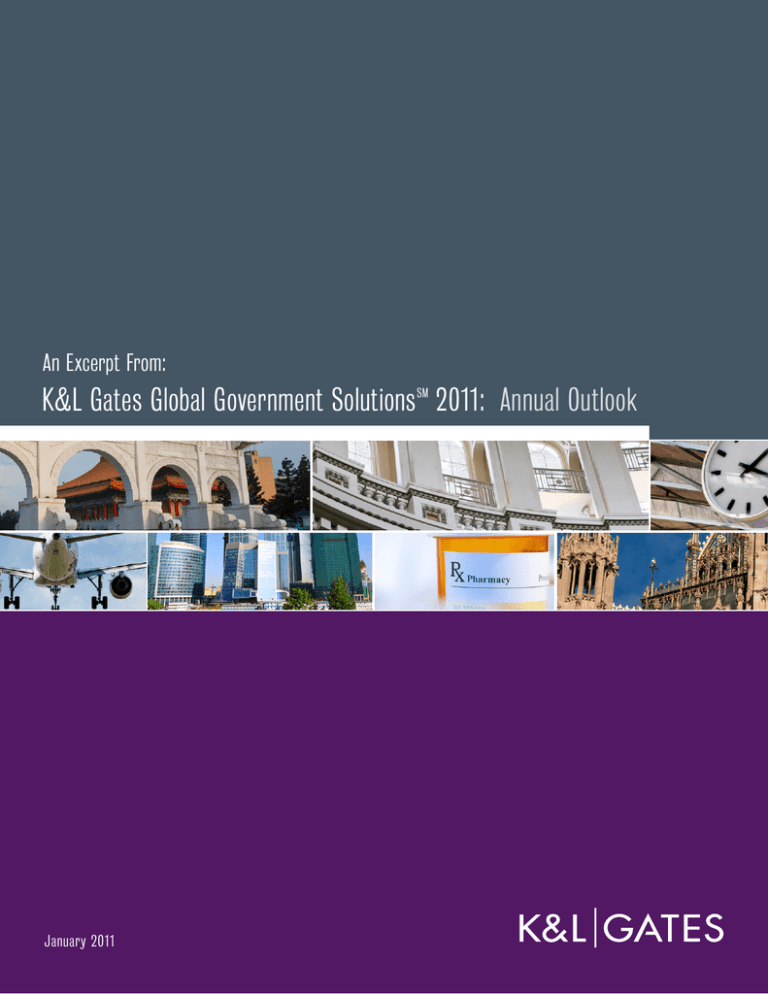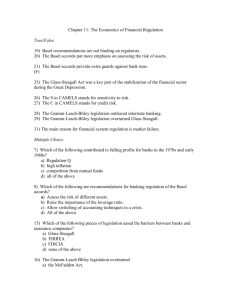
An Excerpt From:
K&L Gates Global Government Solutions SM 2011: Annual Outlook
January 2011
Financial Services
Banks Face “Extremely Demanding” Capital Standards Under Basel III
In 2011, bank regulators across the globe are expected to begin implementing
new capital and liquidity standards issued by the Basel Committee on Banking
Supervision, commonly known as “Basel III.” Following unprecedented government
intervention to shore up the global banking system during the 2008-2009 credit
crisis, the heads of state representing the Group of Twenty (“G-20”) endorsed
Basel III’s general outline at their September 2009 meeting in Pittsburgh. It was an
ambitious plan designed to prevent the need for future government rescues of banks
holding inadequate capital reserves and insufficient liquid assets. Now more fully
developed, these standards will require banks and their holding companies in all
participating countries to increase both the quality of their capital and the amount of
capital held. In the words of Nout Wellink, the chairman of the committee developing
Basel III, it will be “extremely demanding” for banks to meet the new standards.
Among other items, Basel III will:
• Require banks to increase their
common equity, the highest form of
loss absorbing capital, from a global
minimum of 2 percent under Basel II
to 7 percent of risk-weighted assets,
which includes a minimum common
equity level of 4.5 percent and an
individual capital conservation buffer
of 2.5 percent;
• In periods of “excess aggregate
credit growth,” require banks to
have total capital as high as 13
percent of risk-weighted assets, 9.5
percent of which would be common
equity (the 7 percent mentioned
above, plus a 2.5 percent
countercyclical capital buffer);
8
• Increase the quality of capital held
by excluding certain mortgage
servicing rights and other instruments
from the definition of common equity;
• Require banks to hold significantly
more liquid assets;
• Likely slow economic growth by
limiting cash available for lending;
• Likely slow, if not extinguish, markets
for hybrid capital instruments and
subordinated debt; and
• Likely pressure banks to raise capital
to levels above Basel III’s already
significant increases.
The chart on the next page illustrates how
these capital increases will be phased in
between now and 2019.
K&L Gates Global Government Solutions SM 2011 Annual Outlook
Capital Buffers
New “capital buffers” will effectively
require banks to maintain capital in
the form of common equity above the
increased minimum. These capital buffers
will allow banks to absorb losses without
falling below minimum capital levels. If
a bank were to deplete its capital buffer,
general bank operations would not be
affected, but dividends, subordinated
debt payments, and employee bonuses
would be restricted. Thus, although
capital buffers are not technically part of
the required minimum capital, investors
interested in receiving dividends will
likely treat capital buffers as required
capital.
The “countercyclical capital buffer” will
apply only during periods of rapid credit
growth, shoring up capital during good
times in anticipation of expected losses
when the credit markets decline. Critics
object to the countercyclical capital buffer
because it converts capital levels into
a macroeconomic tool, and they doubt
that, as the economy approaches a
period of economic stress bank regulators
will tell banks to begin depleting their
capital reserves.
Financial Services
Increased Capital Quality
Liquidity
Under current capital standards, the key
measure of a bank’s financial strength
is Tier 1 capital, also known as core
capital. Basel III will require additional
Tier 1 capital, but will also shift the
primary focus to common equity by
requiring most Tier 1 capital to qualify
as common equity. While banks face
the need to raise more capital, some
existing instruments will cease to qualify
as regulatory capital.
Basel III also introduces two minimum
liquidity standards—the Liquidity
Coverage Ratio and the Net Stable
Funding Ratio. The Liquidity Coverage
Ratio will require banks to maintain
enough liquid assets to meet their net
cash outflow over 30 days. Net cash
outflow is determined by taking into
account the likely stability of different
types of funding and favors banks with
a large core deposit base over banks
with brokered funds or wholesale funding
sources. Responding to concerns that
short-term creditors withdrew their support
of troubled financial institutions during
The portion of Tier 1 capital that qualifies
as common equity will have to be at
least 4.5 percent of risk-weighted assets,
and generally will be limited to common
stock and retained earnings. Mortgage
servicing rights, deferred tax assets, and
minority investments in subsidiaries will
generally be excluded from common
equity, although a limited exception will
permit their partial treatment as common
equity. At the urging of the United States,
mortgage servicing rights will be allowed
to be counted in an amount of up to 10
percent of common equity.
Banks will have to increase their capital
that counts as Tier 1, which currently
must be at least 4 percent, to 6 percent
of risk-weighted assets. In addition, there
will be a new leverage measure, based
on total (not risk-weighted) assets and offbalance sheet exposures, requiring Tier 1
capital equal to 3 percent of such assets
and exposures.
Cumulative preferred stock, subordinated
debt, and hybrid instruments will
generally qualify as Tier 2 capital, the
least favored form of capital, but only if
they have an original maturity of at least
five years, which is likely to limit their
attractiveness in the marketplace.
The treatment for a bank’s allowance
for loan and lease losses (“ALLL”) has
not been explicitly addressed, but it is
expected that in the United States it will
continue to count as Tier 2 capital, at
least initially.
the height of the financial crisis, the Net
Stable Funding Ratio will require banks
to maintain stable sources of funding
relative to illiquid assets and contingent
obligations over a one-year period,
again favoring banks with stable deposits
and less reliance on wholesale funding.
As regulators refine new liquidity
concepts, one example of potential
controversy in the United States will be
distinguishing between “stable” and
“less stable” deposits. Regulators may
even reconsider their treatment of “core”
and “brokered” deposits because those
categories do not precisely match the
Basel III concepts.
Basel III Minimum Captial Ratios
14%
13%
12%
11%
10.5%
10%
Possible Countercyclical Buffer
(Common Equity)
9.25%
9%
8.625%
Current Well
Capitalized
Total
9.875%
Conservation Buffer
(Common Equity)
8%
7%
Current
Adequately
Capitalized
Total 1 Capital
Total Capital
Current Well
Capitalized
Tier 1 Capital
6%
6%
5.5%
Tier I Capital
5%
Current
Adequately
Capitalized
Tier 1 Capital
4.5%
4%
3.5%
3%
Common Equity
2%
1%
0%
2010
2011
2012
2013
2014
2015
2016
2017
2018
2019
2020
K&L Gates Global Government Solutions SM 2011 Annual Outlook
9
Financial Services
The strongest banks will probably adapt to the new
standards with relative ease...but many significant
banks...may have difficulty raising sufficient capital
and maintaining adequate liquidity.
Implementation
The G-20 nations have endorsed Basel III
and committed to implement its capital
increases before January1, 2013,
after which minimum capital levels will
increase each year through 2019. U.S.
bank regulators support Basel III, and are
expected to fully implement the reforms
through regulation. Given the enactment
of the Dodd-Frank Wall Street Reform
and Consumer Protection Act, no
additional legislative authority is
expected or needed.
A looming question for many banks is
whether regulators or market forces will
require capital levels above Basel III’s
significant increases. In Switzerland,
regulators have endorsed a so-called
“Swiss Finish” that would go beyond the
Basel III minimum. In the United States,
current regulations set the minimum
capital ratio at 8 percent, yet regulators
have used their ratings systems to
effectively raise the minimum requirements
to 10 percent or higher. Other countries
may take similar approaches.
10
While certain components of Basel III
may be manageable, the complete
package of reforms will be a significant
challenge for banking organizations
globally. With the worldwide banking
industry seeking to increase the amount of
capital held, while also replacing many
existing capital instruments with common
equity, banks will likely find it frustrating
to simultaneously build reserves of liquid,
and low-yielding, assets. The strongest
banks will probably adapt to the new
standards with relative ease, especially
given the long phase-in period, but
many significant banks, especially
many European banks and certain
U.S. banks, may have difficulty raising
sufficient capital and maintaining
adequate liquidity.
Rebecca H. Laird (Washington, D.C.)
rebecca.laird@klgates.com
Collins R. Clark (Washington, D.C.)
collins.clark@klgates.com
K&L Gates Global Government Solutions SM 2011 Annual Outlook
Anchorage
Los Angeles
San Diego
Austin
Miami
Beijing
Berlin
Moscow
San Francisco
Boston
Newark
Seattle
Charlotte
New York
Shanghai
Chicago
Dallas
Orange County
Singapore
Dubai
Palo Alto
Fort Worth
Paris
Spokane/Coeur d’Alene
Frankfurt
Pittsburgh
Taipei
Tokyo
Harrisburg
Portland
Raleigh
Hong Kong
London
Research Triangle Park
Warsaw Washington, D.C.
K&L Gates includes lawyers practicing out of 36 offices located in North America, Europe, Asia and the Middle
East, and represents numerous GLOBAL 500, FORTUNE 100, and FTSE 100 corporations, in addition to growth
and middle market companies, entrepreneurs, capital market participants and public sector entities. For more
information, visit www.klgates.com.
K&L Gates comprises multiple affiliated entities: a limited liability partnership with the full name K&L Gates LLP qualified in Delaware and maintaining offices
throughout the United States, in Berlin and Frankfurt, Germany, in Beijing (K&L Gates LLP Beijing Representative Office), in Dubai, U.A.E., in Shanghai (K&L Gates
LLP Shanghai Representative Office), in Tokyo, and in Singapore; a limited liability partnership (also named K&L Gates LLP) incorporated in England and
maintaining offices in London and Paris; a Taiwan general partnership (K&L Gates) maintaining an office in Taipei; a Hong Kong general partnership (K&L Gates,
Solicitors) maintaining an office in Hong Kong; a Polish limited partnership (K&L Gates Jamka sp.k.) maintaining an office in Warsaw; and a Delaware limited
liability company (K&L Gates Holdings, LLC) maintaining an office in Moscow. K&L Gates maintains appropriate registrations in the jurisdictions in which its offices
are located. A list of the partners or members in each entity is available for inspection at any K&L Gates office.
This publication is for informational purposes and does not contain or convey legal advice. The information herein should not be used or relied upon in regard to
any particular facts or circumstances without first consulting a lawyer.
©2011 K&L Gates LLP. All Rights Reserved.




